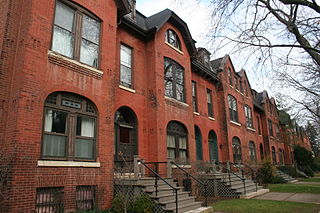
Saint Xavier University is a private Roman Catholic university in Chicago, Illinois. Founded in 1846 by the Sisters of Mercy, the university enrolls 3,749 students.

The Bryn Mawr Apartment Hotel is a 12-story building in the Bryn Mawr Historic District in far-north neighborhood community of Edgewater in Chicago, Illinois. Located on North Kenmore Avenue, it is across the road from the Belle Shore Apartment Hotel. It was designated a historic Chicago Landmark by the Chicago City Council on November 6, 2002.

Amos Alonzo Stagg Field is the name of two successive football fields for the University of Chicago. Beyond sports, the first Stagg Field (1893–1957), named for famed coach, Alonzo Stagg, is remembered for its role in a landmark scientific achievement of Enrico Fermi and the Metallurgical Laboratory during the Manhattan Project. The site of the first artificial nuclear chain reaction, which occurred within the field's west viewing-stands structure, received designation as a National Historic Landmark on February 18, 1965. On October 15, 1966, which is the day that the National Historic Preservation Act of 1966 was enacted creating the National Register of Historic Places, it was added to that as well. The site was named a Chicago Landmark on October 27, 1971.

The Sullivan Athletic Center is an athletic facility on the campus of DePaul University in Chicago, Illinois. The facility houses McGrath-Phillips Arena, a 3,000-seat multi-purpose arena.

The Racquet Club of Chicago is a private social club and athletic club within the Gold Coast Historic District. The classical revival building was designed by architect Andrew Rebori, constructed in 1923. It is a contributing structure within the National Register Gold Coast Historic District.

The Dexter Building was a landmark building located at 630 South Wabash Avenue, in the South Loop area of Chicago, Illinois. The building was designed by the firm of Dankmar Adler and Louis Sullivan, and built in 1887. Prior to its destruction in 2006 it was one of the earliest surviving Louis Sullivan buildings, and was considered a precursor of the nearby Auditorium Building. It was designated as a Chicago Landmark in 1996 and was described by the Landmarks Division of the City of Chicago Department of Planning and Development as an "irreplaceable link in the chain of work of one of the nation's most important architectural partnerships". It was distinctive in its use of exterior perforated girders, prefiguring designs of seven decades later.

The McCormick Row House District is a group of houses located in the Lincoln Park community area in Chicago, Illinois, USA. It sits between East and West parts of DePaul University's Lincoln Park Campus and is independent from the school. They were built between 1884 and 1889 and used by the McCormick Theological Seminary to gain rental income. They were designed in the Queen Anne Style by the A. M. F. Colton and Son architects and joined the list of Chicago Landmarks May 4, 1971. The McCormick Row House District also lies within the boundaries of the Sheffield Historic District.

The Black Metropolis–Bronzeville District is a historic African American district in the Bronzeville neighborhood of the Douglas community area on the South Side of Chicago, Illinois.

The Harris and Selwyn Theaters are twin theatres located in the Loop community area of Chicago, Illinois. They were built by Sam H. Harris and Archie and Edgar Selwyn. They were designated a Chicago Landmark on March 31, 1983. They have been redesigned by the Goodman Theatre, which is located in them.

The Historic Michigan Boulevard District is a historic district in the Loop community area of Chicago in Cook County, Illinois, United States encompassing Michigan Avenue between 11th or Roosevelt Road, depending on the source, and Randolph Streets and named after the nearby Lake Michigan. It was designated a Chicago Landmark on February 27, 2002. The district includes numerous significant buildings on Michigan Avenue facing Grant Park. In addition, this section of Michigan Avenue includes the point recognized as the end of U.S. Route 66. This district is one of the world's best known one-sided streets rivalling Fifth Avenue in New York City and Edinburgh's Princes Street. It lies immediately south of the Michigan–Wacker Historic District and east of the Loop Retail Historic District.

The Wicker Park District is a historic district in the West Town community area of Chicago, Illinois. It is the neighborhood bounded by Bell Avenue, Caton Street, Leavitt Street, Potomac Avenue and Chicago 'L' tracks. It was designated a Chicago Landmark on April 12, 1991.

The Heald Square Monument is a bronze sculpture group by Lorado Taft in Heald Square, Chicago, Illinois. It depicts General George Washington and the two principal financiers of the American Revolution: Robert Morris and Haym Salomon. Following Taft's 1936 death, the sculpture was completed by his associates Leonard Crunelle, Nellie Walker and Fred Torrey.

The Astor Street District is a historic district in Central Chicago, Illinois.

The Jewelers Row District is a historic district in the Loop community area of Chicago, Illinois in the United States. Running along Wabash Avenue, primarily between East Washington Street and East Monroe Street, the buildings in the district were built between 1872 and 1941 and were designed by many architects, including Graham, Anderson, Probst & White, John Mills Van Osdel, Adler & Sullivan, Alfred Alschuler, D. H. Burnham & Co., and Holabird & Roche in a variety of styles, including Italianate, Chicago School, and Art Deco. The buildings are variously loft buildings used for small manufacturers, mercantile buildings, office buildings and early skyscrapers.

The William and Jessie M. Adams House is a Prairie school style house located at 9326 South Pleasant Avenue in Chicago, Illinois.

The Foster House and Stable is a Japanese-influenced house at 12147 South Harvard Avenue in the West Pullman neighborhood of Chicago, Illinois, United States. The house was designed in 1900 by Frank Lloyd Wright as a summer home for Stephen A. Foster, an attorney who worked for real estate developer who helped to build this part of the West Pullman neighborhood. It was designated a Chicago Landmark on May 9, 1996.

The Palliser's Cottage Home No. 35 is a Stick Style house at 2314 West 111th Place in the Morgan Park neighborhood of Chicago, Illinois, United States. Plans for the house appeared in the pattern book of Palliser, Palliser & Co. in 1878 and this house was built in 1882 for Rev. Johan Edgren. It was designated a Chicago Landmark on February 16, 2000.

The Edward C. Waller Apartments are located from 2840 to 2858 W. Walnut Street in Chicago, Illinois. They were designed by Frank Lloyd Wright and built in 1895 and named after Edward C. Waller, a prominent Chicago developer after the 1871 fire. Waller and Wright collaborated on the Waller apartments and the Francisco Terrace apartments to execute Waller's pioneering idea of subsidizing lower income housing. Each apartment was designed with a parlor, chamber (bedroom), dining room, kitchen, bathroom, and closets.

The Milwaukee-Diversey-Kimball District is an official City of Chicago Landmark District straddling the Chicago community areas of Avondale and Logan Square at the gateway to the Polish Village. This district includes 7 buildings in the vicinity of the intersection of Milwaukee Avenue, Kimball Avenue, and Diversey Parkway.



















